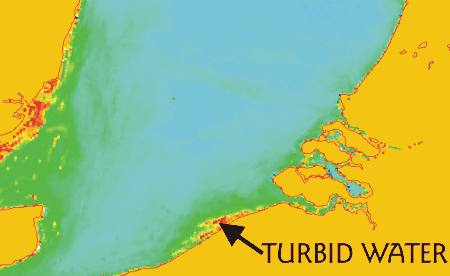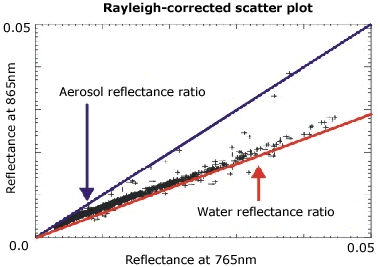Turbid water extension to the standard SeaWiFS and MODIS atmospheric correction
The impossibility of obtaining atmospherically corrected data in the Belgian coastal zone due to the failure of the Standard SeaWiFS atmospheric correction algorithm over turbid waters made us have a closer look at this important problem, and we developed an extension to the standard SeaWiFS algorithm. This extension can easily be implemented within the SeaDAS software. The sources are freely provided and can be downloaded from this web site. Installation and usage instructions are provided.
Brief description
The atmospheric correction algorithm used for production of the standard[1] SeaWiFS and MODIS level 2 products and implemented in the associated SeaDAS processing software encounters problems for turbid waters.
Symptoms found in level 2 products include:
- "atmospheric correction failure" flagging of pixels
- abnormally high values (e.g. > 1.35) for the 765nm:865nm aerosol reflectance ratio, epsilon78
- negative water-leaving radiances for 412nm and 443nm in regions.
As an example Figure 1 shows a SeaWiFs image of the Southern North Sea where no level 2 data is returned for the Belgian coastal waters, a region known to be turbid (e.g. suspended particulate matter concentrations of 10-150 mg/l).



This failure can be attributed to severe overestimation of the 765nm:865nm aerosol reflectance ratio ("eps78"), which arises because of the assumption in calculation of aerosol path radiance that water-leaving radiance for the 765nm and 865nm is zero. While valid for clear open ocean waters, this assumption breaks down for turbid waters. This is illustrated in Figure 2, where the region of turbid water corresponding to the Flemish Banks can be clearly distinguished in the top-of-atmosphere data, suggesting that water-leaving radiance is contributing significantly to top-of-atmosphere radiance.



To overcome this problem a simple extension has been made to the standard SeaWiFS atmospheric correction algorithm, replacing the assumptions of zero water-leaving radiance at 765nm and 865nm by the assumption that the ratio of 765nm:865nm aerosol reflectance and water-leaving reflectance are spatially homogeneous and can be fixed as calibration parameters. While the ratio of water-leaving reflectances is expected to be rather independent of region and time and has been fixed as 1.72 for all images processed so far at MUMM, spatio-temporal variability of the aerosol reflectance ratio can be expected in response to variations in aerosol particle type. Thus, this ratio is assessed on an image-by-image basis by inspection of the scatter plot of the Rayleigh-corrected reflectances at 765nm and 865nm (Figure 3).

Figure 4 shows the results of the turbid water-extended atmospheric correction. The normalised water-leaving radiance at 443nm is now available and positive at nearly all points and shows spatial structures which can be recognised as regions of high suspended particulate matter.



A preliminary validation of this algorithm has been made with a match-up of SeaWiFS data for the Lake Markermeer in the Netherlands against in situ measurements from a hand-held PR-650 spectroradiometer (Figure 5). The error of the standard algorithm is seen to increase for lower wavelengths - a symptom typical of overestimation of eps78 in turbid water – giving negative water-leaving radiances for 412nm, 443nm and even 490nm. This error has been corrected in the turbid water-extended algorithm.

A detailed discussion of the theoretical basis to this algorithm can be found in:
Ruddick K., Ovidio F. & Rijkeboer M. (2000). Atmospheric correction of SeaWiFS imagery for turbid coastal and inland waters. Applied Optics, Vol. 39(6), pp. 897–912. Download
[1] Standard here refers to the multiple-scattering band 7:8 aerosol model of Gordon and Wang [Retrieval of water-leaving radiance and aerosol optical thickness over the oceans with SeaWiFS: a preliminary algorithm. Appl. Opt., 33, 443–452, 1994] with zero NIR water-leaving radiances, as implemented in SeaWiFS reprocessing #2 and in SeaDAS 3.3 as the only atmospheric correction routine.

